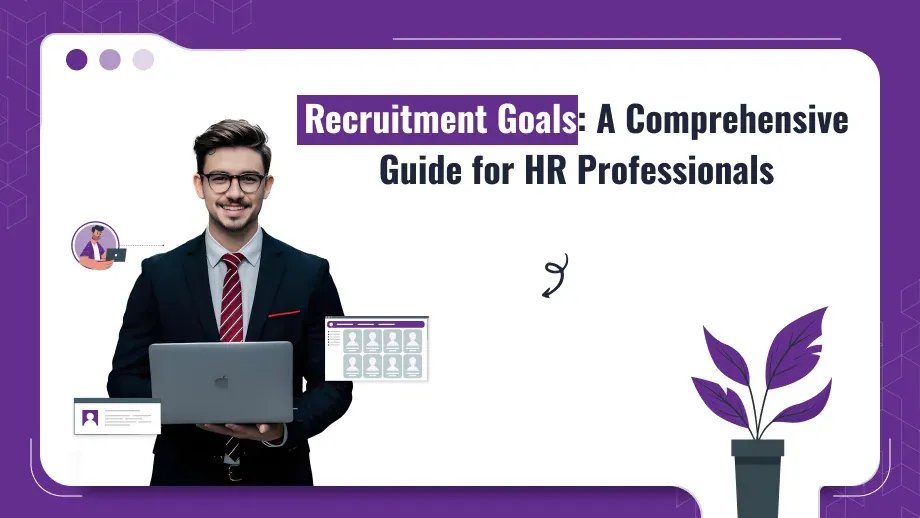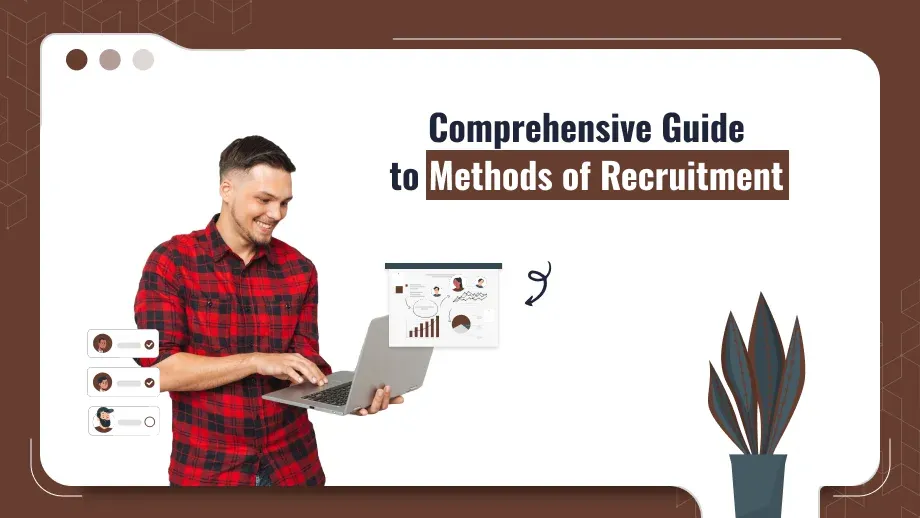
Recruitment goals represent the soul of strategic recruitment. These are the yardsticks by which the effectiveness of activities such as talent attraction, selection, and retention are judged. By those measures, in today’s competitive labor market, each decision made regarding selection contributes directly toward companywide achievement.
This blog will explore the importance of recruitment goals, how to set and achieve them, and practical strategies to overcome common recruitment challenges. We’ll also address how to apply Smart goals for recruiters to refine your hiring process and maximize efficiency.
Why Recruitment Goals Matter
More than hiring to fill a void, recruitment gets the right people for the position that will help the organization. The goals of recruitment help your hiring process be intentional and focused on results, just like your organization’s objectives.
When HR teams and recruiters establish their goals, they can:
- Enhance the efficiency of the hiring process
- Align their recruitment efforts with long-term organizational goals.
- Build a talent pool that supports innovation and growth.
In this blog, we’ll explore the following:
- What are recruiting goals in HRM?
- Answering what is the goal of recruiting?
- How to set SMART goals for recruiters.
- Overcoming recruiting challenges with actionable strategies.
By the end, you’ll have a robust understanding of how to set and achieve meaningful recruitment goals.
What is the Goal of Recruiting?
Recruitment aims to attract and hire the right talent and retain it. But in HRM, however, this simple objective is broadened. Recruiting, for instance, finds a way of creating a sustainable hiring strategy that aligns with the organization’s broader mission.
Key Objectives of Recruiting in HRM:
- Attract Qualified Talent: The main goal is to identify and attract candidates who will help achieve the right skills, experience, and cultural fit for the organization.
- Reduce Time-to-Hire: Shortening the hiring process ensures that seats are filled almost immediately with little to no setbacks within operations.
- Ensure Quality in the Candidate Base: Quality hires will be those who do not only perform well in their jobs but also those who have a positive impact on company culture.
- It expands diversity: most organizations strive to build a diverse workforce because it is innovative and inclusive.
- Employer Branding: Recruitment should also help promote the employer brand. Strong employer branding attracts top talent and saves in the recruitment process.
I can use this case study: if your company is scaling very fast, one recruitment goal can be hiring 50 professionals with the right skills for key positions within six months.
Goal Setting for Recruiters
For recruiters, goal setting would ensure that each hiring decision made is purposeful and driven by business needs. If there is no clear goal setting, the recruitment process becomes inefficient and misshaped.
Steps to Set Recruitment Goals:
- Understand Organizational Needs:
Evaluate workforce gaps, future growth plans, and skills needed for upcoming projects. For instance, a technology company may target the recruitment of software engineers, with a specialty in niche areas.
- Use Recruitment Metrics to Identify Areas of Improvement:
The following are some of the most critical metrics in setting goals: time-to-hire, cost-per-hire, and quality of hire. For instance, if your average time-to-hire is 45 days, you can set a goal to try reducing it to 30 days.
- Align Goals with Business Objectives:
Recruitment goals should, therefore, be aligned with the company’s strategic priorities. For instance, if the business is looking to penetrate new markets, your recruitment goal could be appointing experts in those regions.
- Leverage Technology:
Use tools like applicant tracking systems to streamline workflows, improve efficiency, and track performance against goals.
- Incorporate Internal Recruitment:
Promoting from within can reduce hiring costs and fill roles faster. Make it a goal to source a certain percentage of hires internally.
Turn your recruitment goals into measurable success!
Find the perfect payroll management system for your team – right now!.
Smart Goals for Recruiters
Using the SMART framework, setting goals for recruiters is very rewarding.
How to Set Smart Goals for Recruiters:
- Specific:
Clearly define your goal. Instead of saying “Improve hiring,” specify: “Hire 30 developers with JavaScript expertise within six months.”
- Measurable:
Assign measurements to your goals. Track metrics such as the number of candidates interviewed offer acceptance rates, or cost-per-hire.
- Achievable:
Set feasible goals based on available resources. For example, a complete 50 percent reduction in hiring time will not be achievable without significant process changes.
- Relevant:
The goal should also be congruent with overall company priorities. For example, if the business is entering the e-commerce market, recruit experts in that domain.
- Time-Bound:
Deadlines must be assigned to give urgency and the aspect of accountability. For example: “Increase diversity hiring to leadership roles by 25% within six months.”
Smart Goal Examples for Recruiters:
- Raises the acceptances offered by 10 percent through enhanced communication and competitive packages.
- Reduce the technical hiring cycle by 20% in the next quarter using applicant tracking systems.
- Enhance candidate satisfaction by 30% through better interview experiences within three months.
Key Recruiting Goals in HRM
Recruitment goals vary across organizations but generally focus on specific aspects of the hiring process. Here are some critical goals that HR professionals should consider:
Reducing Time-to-Hire:
Time-to-hire refers to how long it takes from posting a job opening to the start date of the candidate. Long hiring cycles often result in losing top contenders to competitors.
How to Reduce Time-to-Hire:
- Implement applicant tracking systems to make routine processes like resume screening.
- Streamline interview processes by eliminating unnecessary rounds and using recruitment texting templates to schedule interviews faster.
- Promote internal recruitment for roles that can be fulfilled by the existing employees.
Improving Candidate Quality:
Quality of hire is an essential metric that measures how well a new hire meets job expectations and contributes to the company.
Strategies to Improve Candidate Quality:
- Train hiring managers on effective recruitment skills to assess candidates better.
- Use pre-employment testing and structured interviewing to better assess candidates.
- Improve the job description to ensure that the right candidate is acquired.
Enhancing Diversity:
Diversity hiring should be the backbone of establishing a creative and diversified workforce.
Steps to Promote Diversity:
- Partner with organizations that advocate for underrepresented groups.
- Rewrite job postings to attract a diverse talent pool.
- Utilize analytics tools that measure and track diversity metrics within your hiring pipeline.
Strengthening Employer Branding:
Employer brands can be used for cost-effective hiring as well as attracting better-quality candidates.
- Employee Testimonials and Success Stories on Social Media
- Talk about the culture, values, and benefits of your organization through recruitment marketing.
- Treat applicants kindly in every phase of the hiring process.
How to Set Recruitment Goals
Understanding the Importance of Recruitment Goals
Recruitment goals provide a roadmap and direction for the hiring process. This makes sure efforts are intentional as well as aligned with the company’s broader objectives. It helps in:
- Identify Top Priorities: Identify clearly what matters most in terms of recruitment campaigns- speed, quality, or any other aspect.
- Measure Success: Establish marks through which it is possible to measure the efficacy of recruitment plans.
- Improve Efficiency: Use resources on clearly defined outcomes. This will eventually save time as well as effort.
- Align to Business Objectives: Verify that every hiring decision supports the company’s growth and serves its mission.
For example, if there is an expansion into a new market, recruitment objectives can be aimed at bringing in experts with local area knowledge or languages.
Align Recruitment Goals with Business Objectives
Recruitment should help the company meet its strategic priorities. Meaningful recruitment goals set in this regard are:
- Involve Leadership: The chairman or other executives should be consulted and department heads to discuss their plans and needs for recruitment.
- Workforce Gaps: Identify missing skills and jobs that are currently lacking to achieve business objectives.
- Impact Focus: Make the recruitment objective focus on the impact of business results in terms of turnaround or productivity gain.
Example Objective: Recruit 15 software engineers over the next three months to support a new product line.
Leverage Recruitment Metrics
Data is heavily involved in establishing and achieving recruitment objectives. A few critical metrics are:
- Time-to-Hire: The time between posting for a job opening and when the candidate accepts an offer.
- Quality of Hire: The quality of hire about performance and length of stay with the organization.
- Cost-per-hire: Total hiring expense, including advertising, recruitment tools, and onboarding.
- Offer Acceptance Rate: Percentage of offered jobs accepted.
- Diversity Metrics: The level to which different demographic groups are represented in the hiring pipeline.
Example: The current to hire is 45 days. A goal could be to reduce it to 30 days by improving workflow and leveraging the right mix of technology, such as an applicant tracking system.
Set Goals for Candidate Experience
A positive candidate experience impacts employer branding and offers acceptance rates. Steps to improve candidate experience include:
- Smooth communication: Candidates should be informed at every stage of the hiring process without delay.
- Simplify the Application Process: Reduce the steps involved and make it mobile-friendly.
- Request Feedback: Use surveys to capture insights from candidates regarding their experience and make improvements.
Example Goal: Increase candidate satisfaction score by 30% in the upcoming quarter through communication and simplifying the interview process.
Challenges in Setting Recruitment Goals
The recruiters, while determining the recruitment objectives and how to attain them, face several challenges that can even upset the best-planned recruitment plans.
Common Recruiting Challenges:
- Talent Shortages:
Finding the right candidates at times for niche roles is challenging, especially in a competitive industry.
- High Competition:
Organizations compete for the same stock of talent, which further limits their chances.
Misalignment between hiring managers and recruiters can result in impractical goals.
- Lack of Data:
Without metrics, it’s tough to look at bottlenecks and improve the process.
Solutions to Overcome Challenges:
- Leverage Technology: Installing applicant tracking systems that will give data that will help streamline the tasks and efficiency.
- Emphasize Methods of Recruitment: Diversifying hiring methods like employee referrals, campus recruitment, and partnerships with external agencies.
- Stakeholder Expectations Alignment: Keeping in close communication with hiring managers. Setting realistic and achievable goals that they agree with.
Best Practices for Goal-Oriented Recruiting
To accomplish your recruitment goals, use the following best practices:
- Use Recruitment Metrics:
Track metrics for time-to-fill, quality of hire, and cost-per-hire to measure performance and opportunities for improvement.
- Automate Processes:
Invest in tools like the best HRMS Payroll Software in India to manage hiring workflows, track progress, and streamline processes.
- Enhance Candidate Experience:
A positive candidate experience improves employer branding and increases offer acceptance rates.
- Leverage Recruitment Marketing:
Use targeted campaigns to reach passive candidates and highlight your company’s unique strengths.
- Invest in Training:
Continuous improvement of recruitment skills for hiring managers and recruiters to ensure improved hiring decisions are made.
Conclusion
Recruitment goals are not merely replacement of positions but rather creation of talent, which drives business success. In setting Smart goals and addressing recruiting challenges, technology, such as applicant tracking systems, can play a vital role.
First, evaluate your current recruitment strategies, set actionable goals, and implement tools and best practices to achieve them. The right approach can help you attract top talent, better the hiring outcomes, and further the growth of your organization.






